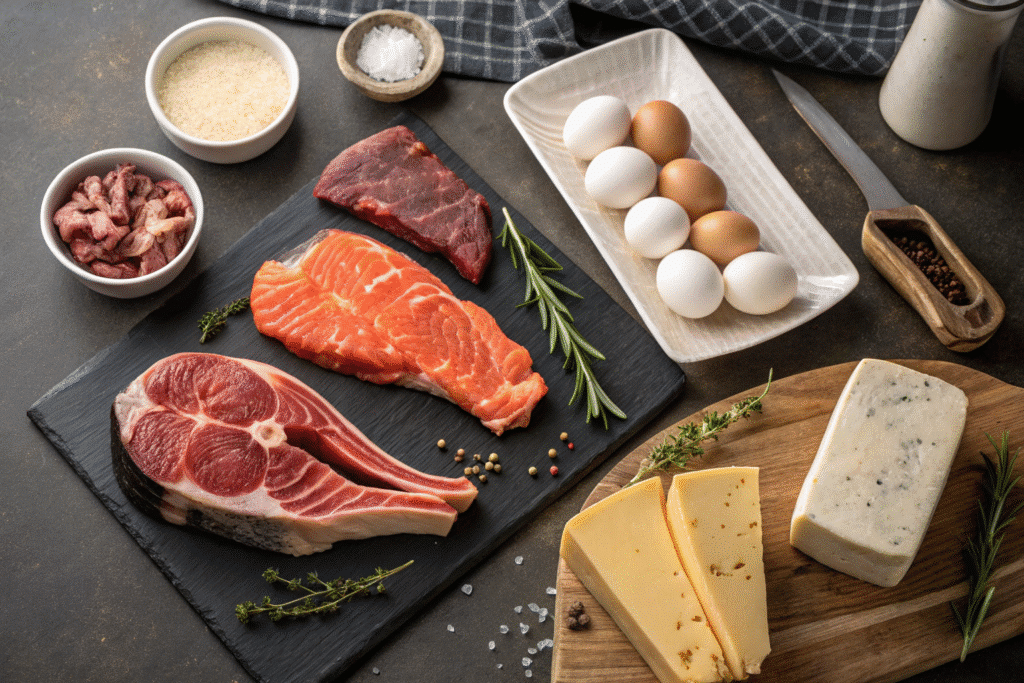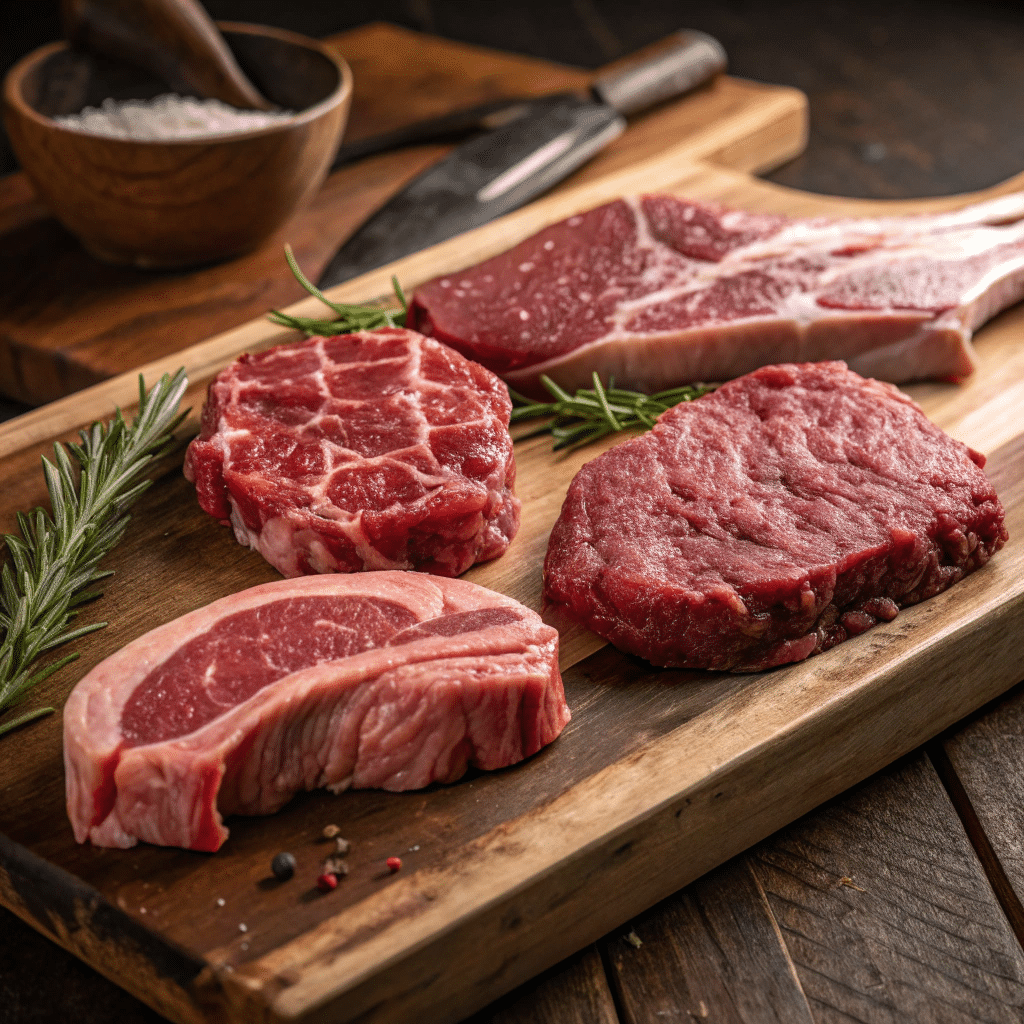Carnivore grocery list was the very first thing I searched when I decided to try this lifestyle. I was done with long ingredient lists, overcomplicated plans, and underwhelming results. I needed clarity—something simple, nourishing, and deeply satisfying.
This list became my anchor. Every week, I returned to the same essentials: fatty meats, eggs, broth, and organ meats. No more decision fatigue, no more kitchen overwhelm. This guide breaks down exactly what you need to shop like a carnivore, eat with ease, and feel your best—starting today.

Table of Contents
Table of Contents
Carnivore Grocery List Basics: Your Must-Haves
Focus on Fatty, Nutrient-Dense Cuts
The first rule of a smart carnivore grocery list? Prioritize high-fat, nutrient-rich meats. These cuts fuel your body, eliminate cravings, and keep you full for hours:
- Ribeye steak
- Ground lamb
- Lamb shoulder
- Chuck roast
- Beef short ribs
Fatty cuts support hormone health, brain function, and metabolism—all while tasting incredible. Want to save time? This carnivore meal prep guide helps you prep once and eat well all week.
Eggs, Broth & Organs: Don’t Skip These
Eggs and bone broth are foundational. They’re easy, affordable, and full of nutrients. I started most mornings with soft-boiled eggs and a warm mug of broth—it was pure comfort with real nourishment.
As for organs? Don’t be afraid of liver, heart, or kidney. They’re powerful, especially for healing and hormone balance. If you’re unsure where to begin.
Carnivore Grocery List for Weekly Planning and Simplicity
Build a Weekly Rhythm, Not Just a Cart
One of the best things I learned was to stop shopping like I used to. With a proper carnivore grocery list, I started shopping in rhythms—not random items. I created weekly meal anchors like ribeye for dinner, eggs and liver for breakfast, and bone broth as a daily staple.
Here’s an example of how to structure your carnivore grocery list by meal time:| Meal | Core Grocery Items |
|---|---|
| Breakfast | Eggs, beef tallow, liver, bone broth |
| Lunch | Ground beef, salmon, leftover lamb chops |
| Dinner | Ribeye, chuck roast, marrow bones |
You’ll waste less, stress less, and always have something ready to go. To keep it even easier, I use this 7-day carnivore meal plan as my foundation each week.
Keep Your Pantry Carnivore-Friendly
While fresh meat matters most, having a few pantry items ready makes sticking to carnivore much easier:
- Sea salt or Redmond Real Salt
- Freeze-dried liver snacks
- Canned sardines or mackerel in water
- Collagen powder (if tolerated)
Most beginners overthink it. But truthfully, your pantry doesn’t need to be stocked with anything that doesn’t come from an animal. Keep it clean and minimal. If you’re just starting out, my carnivore for beginners guide walks you through all the essentials
Carnivore Grocery List on a Budget: Eat Well Without Overspending
Smart Shopping Without Sacrificing Quality
Eating animal-based doesn’t have to break your budget. When I first built my carnivore grocery list, I assumed I’d need grass-fed everything. But over time, I learned it’s all about knowing where and how to shop. With the right strategy, even ribeye can become a weekly staple.
Here’s how I started saving without lowering quality:
- Buy in bulk: I purchase ground beef and chuck roast in bulk from local butchers or warehouse clubs.
- Rotate cuts: Lamb shoulder one week, pork ribs the next. Keeps things interesting and affordable.
- Prioritize fat-rich cuts: They’re cheaper, more filling, and perfect for this lifestyle.
If you’re building your first cart, my carnivore meal prep guide helps you plan meals that stretch over multiple days—less waste, more value.
Best Places to Buy Carnivore Foods (Online & Local)
Here’s where I’ve personally found the best deals and reliable quality for carnivore essentials:
- Local butchers: Many offer better prices than supermarkets, especially on organ meats and bones.
- Farmers markets: You’ll find fresh pasture-raised options and build relationships with local producers.
- Online sources: Sites like White Oak Pastures or US Wellness Meats offer bundled savings and subscription discounts.
Don’t overlook your grocery store either—store-brand eggs, bone-in chicken thighs, or sardines are still solid. For a complete look at what to buy, this grocery list for carnivore beginners breaks it down food by food.

Carnivore Grocery List Mistakes: What to Avoid at All Costs
Hidden Ingredients That Sabotage Progress
One of the biggest shocks I had as a beginner was realizing how many “meat” products weren’t actually carnivore-friendly. Just because it’s in the meat aisle doesn’t mean it’s clean. When building your carnivore grocery list, always check labels—because what you avoid matters just as much as what you eat.
Avoid these common pitfalls:
- Deli meats with dextrose, maltodextrin, or seed oils.
- Sausages with fillers like soy, starch, or hidden sugars.
- Packaged broths with yeast extract or “natural flavors.”
Even pre-cooked rotisserie chickens often contain sugar and preservatives. That’s why I now make my own broth (check my collagen-rich recipe) and season everything myself using just salt.
What NOT to Include on Your Carnivore Grocery List
Many carnivore beginners unknowingly sabotage their results by adding “borderline” foods to their grocery list. These include:
- Zero-carb snacks with artificial sweeteners
- Nut-based cheese alternatives or keto breads
- Plant-based oils like avocado or olive oil
These aren’t part of a true carnivore approach. If you’re serious about resetting your metabolism, stick to animal-based foods only. Meat, eggs, fish, animal fats, and broth are more than enough to nourish and sustain.
To stay focused, I keep my shopping list tight. For quick reference, this 7 Day Carnivore Meal Plan shows exactly what I buy and how I turn it into satisfying meals all week long.
Carnivore Grocery List Strategy: Build It Like a Pro
Weekly Staples vs. Rotational Items
If you’re serious about sticking to carnivore, your grocery list needs structure. I learned the hard way that buying random meats each week left me either overwhelmed or under-prepared. That’s why I now split my carnivore grocery list into two categories:
Staples (always on the list):
- Ground beef
- Ribeye or chuck roast
- Eggs (2–3 dozen)
- Bone broth (homemade or unsalted store-bought)
- Butter or beef tallow
- Chicken thighs or whole chicken
Rotational Items (optional, seasonal, or budget-based):
- Lamb (shoulder or chops)
- Beef liver or kidney
- Wild salmon or sardines
- Pork belly or pork ribs
- Duck or bison (if available)
This simple split helps you avoid decision fatigue, saves money, and keeps your meals enjoyable without straying off track.
Budget Tips for Carnivore Shopping
You don’t need to spend a fortune to eat clean. I get this question often: “Isn’t carnivore expensive?” Not if you shop smart. Here’s what helped me keep it sustainable:
- Buy in bulk (Costco or local farms).
- Choose ground meat over steak more often.
- Use whole chicken or pork shoulder for slow cooking—cheaper and versatile.
- Skip pre-packed snacks or “keto extras”—they add cost and confusion.
Conclusion
Carnivore Grocery List is your foundation for real change. It’s not just a list—it’s a weekly commitment to eating clean, powerful, and nourishing food. Whether you’re a beginner or transitioning from keto, this guide helps you build structure, shop smart, and eat with intention.
Forget fads and food noise. With the right carnivore grocery list, you’ll fuel your body, simplify your week, and take back your health—one meal at a time.
That’s the power of the Carnivore Grocery List.
For More Recipes Follow me in Facebook and Pinterest
FAQs
What can you eat on a carnivore diet list?
You can eat beef, lamb, pork, chicken, turkey, organ meats, eggs, bone broth, seafood like salmon or sardines, and animal fats such as tallow or butter. Simplicity is key—stick to whole, animal-based foods.
How many eggs a day do carnivores eat?
There’s no strict number, but most eat between 2–6 eggs per day depending on hunger, protein needs, and tolerance. Eggs are a cost-effective protein and fat source, especially early in the diet.
What is a 100% carnivore diet?
A 100% carnivore diet means eating only animal-based foods—no vegetables, fruits, grains, or plant oils. You focus entirely on meat, eggs, broth, and animal fats for all nourishment.
What is forbidden on the carnivore diet?
You should avoid all plant foods, processed sugar, grains, legumes, seed oils, and anything artificial. No almond flour, stevia, or vegetables. Stick to animal products only.
What is the 7 day carnivore diet?
It’s a focused one-week reset where you eat only meat, eggs, and broth. It’s ideal for beginners and helps eliminate inflammation, reset hunger cues, and improve digestion quickly.
Why do I feel so bad on the carnivore diet?
That’s common during the adaptation phase. It usually means you’re losing electrolytes or under-eating. Add salt, drink bone broth, and focus on fatty meats to recover faster.
What’s a good carnivore breakfast?
Start your day with 3–4 eggs fried in tallow or butter, paired with leftover steak or ground beef. Add broth if you’re low on energy or need hydration.
